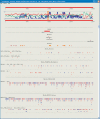PromAn: an integrated knowledge-based web server dedicated to promoter analysis
- PMID: 16845074
- PMCID: PMC1538850
- DOI: 10.1093/nar/gkl193
PromAn: an integrated knowledge-based web server dedicated to promoter analysis
Abstract
PromAn is a modular web-based tool dedicated to promoter analysis that integrates distinct complementary databases, methods and programs. PromAn provides automatic analysis of a genomic region with minimal prior knowledge of the genomic sequence. Prediction programs and experimental databases are combined to locate the transcription start site (TSS) and the promoter region within a large genomic input sequence. Transcription factor binding sites (TFBSs) can be predicted using several public databases and user-defined motifs. Also, a phylogenetic footprinting strategy, combining multiple alignment of large genomic sequences and assignment of various scores reflecting the evolutionary selection pressure, allows for evaluation and ranking of TFBS predictions. PromAn results can be displayed in an interactive graphical user interface, PromAnGUI. It integrates all of this information to highlight active promoter regions, to identify among the huge number of TFBS predictions those which are the most likely to be potentially functional and to facilitate user refined analysis. Such an integrative approach is essential in the face of a growing number of tools dedicated to promoter analysis in order to propose hypotheses to direct further experimental validations. PromAn is publicly available at http://bips.u-strasbg.fr/PromAn.
Figures



Similar articles
-
CONREAL web server: identification and visualization of conserved transcription factor binding sites.Nucleic Acids Res. 2005 Jul 1;33(Web Server issue):W447-50. doi: 10.1093/nar/gki378. Nucleic Acids Res. 2005. PMID: 15980509 Free PMC article.
-
CRSD: a comprehensive web server for composite regulatory signature discovery.Nucleic Acids Res. 2006 Jul 1;34(Web Server issue):W571-7. doi: 10.1093/nar/gkl279. Nucleic Acids Res. 2006. PMID: 16845073 Free PMC article.
-
e2g: an interactive web-based server for efficiently mapping large EST and cDNA sets to genomic sequences.Nucleic Acids Res. 2004 Jul 1;32(Web Server issue):W301-4. doi: 10.1093/nar/gkh478. Nucleic Acids Res. 2004. PMID: 15215398 Free PMC article.
-
Current bioinformatics tools in genomic biomedical research (Review).Int J Mol Med. 2006 Jun;17(6):967-73. Int J Mol Med. 2006. PMID: 16685403 Review.
-
[Integrated computer system for regulating eukaryotic gene expression].Mol Biol (Mosk). 2004 Jan-Feb;38(1):69-81. Mol Biol (Mosk). 2004. PMID: 15042837 Review. Russian.
Cited by
-
Contrasting patterns of transposable element insertions in Drosophila heat-shock promoters.PLoS One. 2009 Dec 29;4(12):e8486. doi: 10.1371/journal.pone.0008486. PLoS One. 2009. PMID: 20041194 Free PMC article.
-
Fine-tuning of intrinsic N-Oct-3 POU domain allostery by regulatory DNA targets.Nucleic Acids Res. 2007;35(13):4420-32. doi: 10.1093/nar/gkm453. Epub 2007 Jun 18. Nucleic Acids Res. 2007. PMID: 17576670 Free PMC article.
-
Functional promoter testing using a modified lentiviral transfer vector.Mol Vis. 2007 May 17;13:730-9. Mol Vis. 2007. PMID: 17563724 Free PMC article.
-
Critical assessment of computational tools for prokaryotic and eukaryotic promoter prediction.Brief Bioinform. 2022 Mar 10;23(2):bbab551. doi: 10.1093/bib/bbab551. Brief Bioinform. 2022. PMID: 35021193 Free PMC article.
-
Transcriptional activation of REST by Sp1 in Huntington's disease models.PLoS One. 2010 Dec 14;5(12):e14311. doi: 10.1371/journal.pone.0014311. PLoS One. 2010. PMID: 21179468 Free PMC article.
References
-
- Tagle D.A., Koop B.F., Goodman M., Slightom J.L., Hess D.L., Jones R.T. Embryonic epsilon and gamma globin genes of a prosimian primate (Galago crassicaudatus). Nucleotide and amino acid sequences, developmental regulation and phylogenetic footprints. J. Mol. Biol. 1988;203:439–455. - PubMed
-
- Wasserman W.W., Palumbo M., Thompson W., Fickett J.W., Lawrence C.E. Human-mouse genome comparisons to locate regulatory sites. Nature Genet. 2000;26:225–228. - PubMed
Publication types
MeSH terms
Substances
LinkOut - more resources
Full Text Sources
Other Literature Sources

